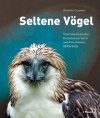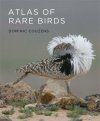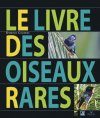Art / Photobook Distribution Atlas
Out of Print
By: Dominic Couzens(Author)
240 pages, 200 colour photos, 61 maps
![Seltene Vögel Seltene Vögel]()
Click to have a closer look
About this book
Related titles
Recommended titles
About this book
Language: German
A guide to some of the rarest birds in existence, brought together by the maps showing where in the world you can find them. The book focuses on 50 captivating stories of the very rare, including remarkable discoveries of species new to science, rediscoveries of species not seen for centuries and 'back from the brink of extinction' successes like Seychelles Magpie-Robin and California Condor. Each species has its own mini-chapter and the book will be broken down into key groups of species, with the five most amazing tales of island endemics, five most bizarre cases of a bird becoming threatened, and so on.
This is an accessible, readable and visually appealing take on a serious subject of threatened birds and possible extinctions – a topic that is constantly in the news due to increasing concerns over climate change and habitat destruction. The atlas format shows the global nature of the problem and brings together the many strands of the concerted bird conservation effort that is taking place on every continent. It also lends and element of accessibility to the reader as many of the species featured can be watched on birding tours these days.
Summary in German:
Reich bebildert mit Fotos und Karten erzählt dieses Buch die fesselnden Geschichten von 50 Vogelarten, die zu den seltensten der Welt gehören. Dominic Couzens hat die spannendsten Fälle ausgewählt und porträtiert Vögel, die dank Schutzprojekten überlebt haben, und Arten, deren Zukunft trotz vieler Bemühungen nicht gesichert ist:
- Aus höchster Not gerettet: Auf einer Zahl von 60 Tieren basierte das Nachzuchtprogramm, das den Kalifornischen Kondor vor Aussterben verschonte – zumindest vorläufig.
- Vogelschutz als völkerverbindendes Projekt: Nur dank der Zusammenarbeit von japanischen und chinesischen Forschern konnte der wunderbar befiederte Nipponibis vor dem Untergang gerettet werden.
- Von der Gefahr zu hoher Spezialisierung: Der Spix-Ara braucht den Caraibeira-Baum, der Caraibeira-Baum wächst nur auf Böden, die sich besonders gut für den Maisanbau eignen. Der Interessenkonflikt war vorgezeichnet.
- Wiederentdeckt: Erst 108 Jahre nach der letzten Sichtung wurde die Art wieder beobachtet – die Neuseeländische Sturmschwalbe.
Customer Reviews


























![Libellen Europas: Der Bestimmungsführer [Field Guide to the Dragonflies of Britain and Europe]](http://mediacdn.nhbs.com/jackets/jackets_resizer_medium/25/251176.jpg?height=150&width=95)
![Flora Helvetica: Illustrierte Flora der Schweiz [Flora Helvetica: Illustrated Flora of Switzerland]](http://mediacdn.nhbs.com/jackets/jackets_resizer_medium/26/264404.jpg?height=150&width=101)
![Lebensraum Federkleid: Federn und Federbewohner Heimischer Vögel [Plumage as Habitat: Feathers of Domestic Birds and their Parasitic Residents]](http://mediacdn.nhbs.com/jackets/jackets_resizer_medium/22/225536.jpg?height=150&width=103)
![Flora Vegetativa: Ein Bestimmungsbuch für Pflanzen der Schweiz im Blütenlosen Zustand [Flora Vegetativa: An Identification Book for Plants in Switzerland without Flowers]](http://mediacdn.nhbs.com/jackets/jackets_resizer_medium/24/249633.jpg?height=150&width=98)
![Schmetterlinge der Alpen: Der Bestimmungsführer für alle Arten [Butterflies of the Alps: Identification Guide to All Species]](http://mediacdn.nhbs.com/jackets/jackets_resizer_medium/21/210853.jpg?height=150&width=95)
![Pilzführer Schweiz [Mushroom Guide to Switzerland]](http://mediacdn.nhbs.com/jackets/jackets_resizer_medium/24/241878.jpg?height=150&width=103)

![Jugendstadien der Heuschrecken der Schweiz [Juvenile Stages of the Grasshoppers of Switzerland]](http://mediacdn.nhbs.com/jackets/jackets_resizer_medium/25/252131.jpg?height=150&width=103)
![Farne, Schachtelhalme und Bärlappe: Der Naturführer zu den Farnpflanzen Mitteleuropas [Ferns, Horsetails and Clubmosses: The Field Guide to the ferns of Central Europe]](http://mediacdn.nhbs.com/jackets/jackets_resizer_medium/25/254162.jpg?height=150&width=104)
![Das Herbarium des Felix Platter: Die Älteste Wissenschaftliche Pflanzensammlung der Schweiz [The Herbarium of Felix Platter: The Oldest Scientific Plant Collection of Switzerland]](http://mediacdn.nhbs.com/jackets/jackets_resizer_medium/23/230349.jpg?height=150&width=120)
![Die Geheimnisvolle Welt der Pilze: Das Natur-Mitmachbuch für Kinder [The Mysterious World of Fungi: The Nature Activity Book for Children]](http://mediacdn.nhbs.com/jackets/jackets_resizer_medium/22/225586.jpg?height=150&width=136)
![Landschaften und Geologie der Schweiz [Landscapes and Geology of Switzerland]](http://mediacdn.nhbs.com/jackets/jackets_resizer_medium/24/245388.jpg?height=150&width=99)